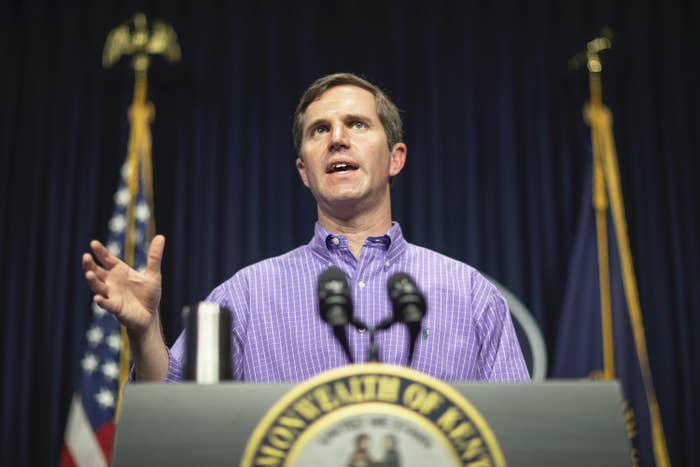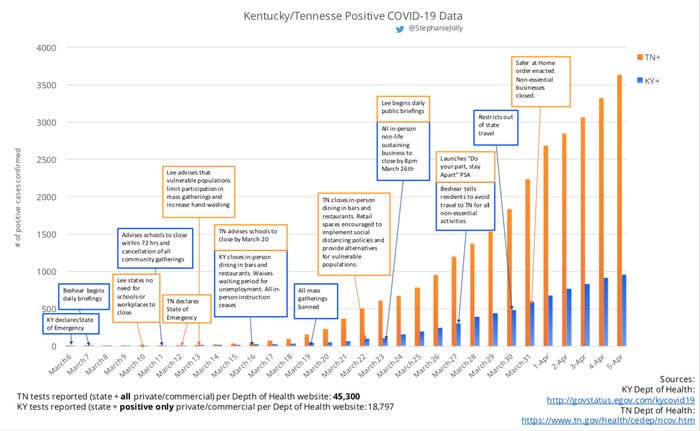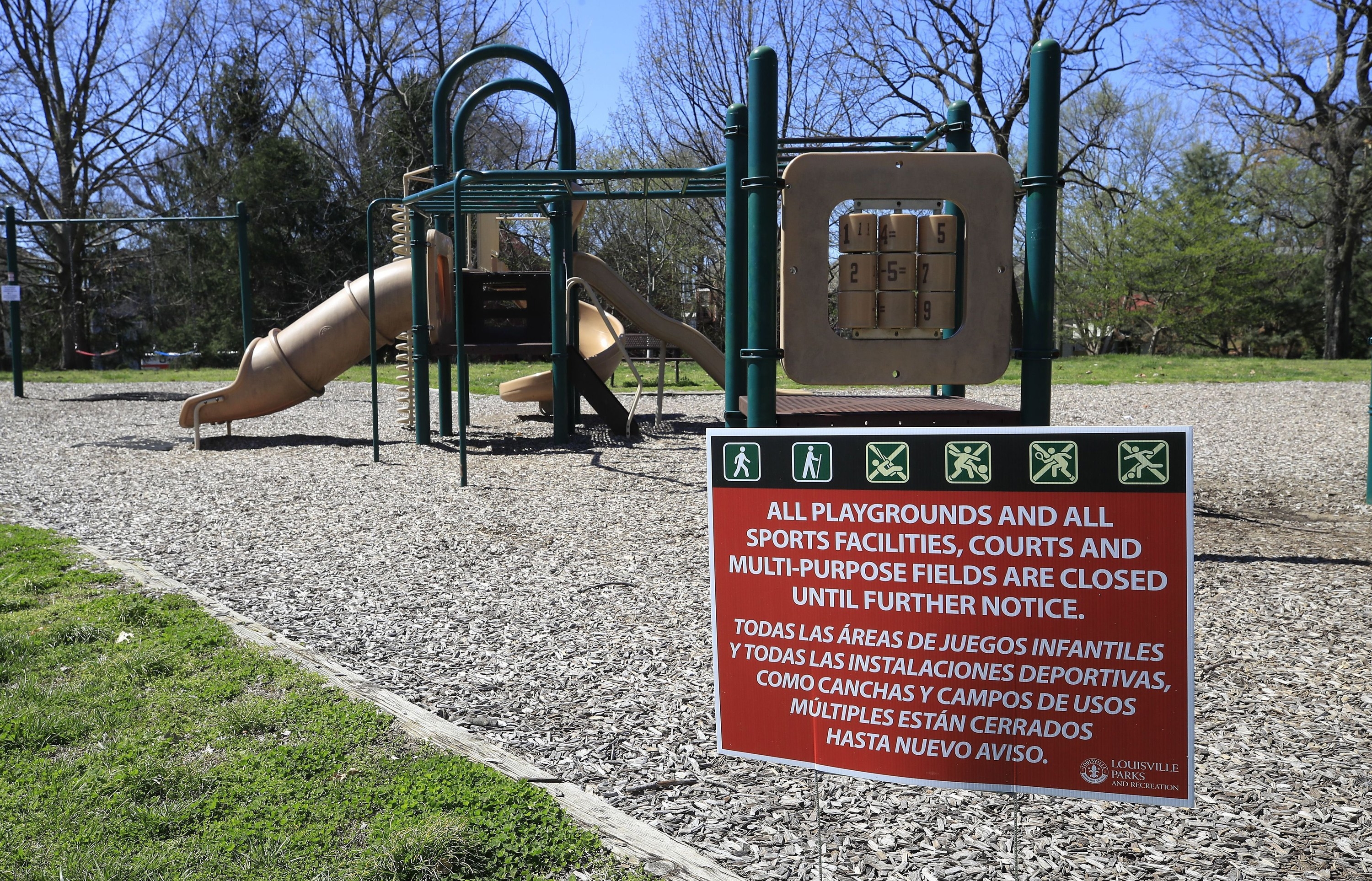
A natural experiment in stopping the spread of the novel coronavirus is playing out on the border between Kentucky and Tennessee, where an early start to social distancing is pitted against a late one.
As of Saturday, Kentucky is now reporting 1,840 cases and 94 deaths, while as of Sunday, Tennessee is reporting 5,308 cases and 101 deaths. Kentucky Gov. Andy Beshear declared a state of emergency on March 6, while neighboring Tennessee’s Bill Lee waited until March 12, and then took until the end of the month to suggest people stay at home. The two approaches led to two drastically different outcomes playing out on the national stage.
"Honestly, it was just a matter of curiosity,” said Stephanie Jolly, a Kentucky resident and educator whose plot of the contrasting timelines and COVID-19 case numbers went viral on Facebook. Inspired by a now-famous chart depicting the stark difference in deaths between the early shutdown of St. Louis and the late one in Philadelphia during the 1918 influenza pandemic, she set out to make her chart looking for a modern-day comparison. St. Louis saw only 1,703 deaths from the influenza pandemic, while Philadelphia suffered the worst fatality rate in the nation, with over 16,000 people dead in six months.
Ironically enough, Jolly was quarantined in New York City while waiting for thyroid cancer surgery there as that city became the center of the US outbreak. She posted the first version of her chart on Facebook on March 19, just to share with her group of friends. “I woke up to find it had gone everywhere,” she said.

The next day, March 21, the chart spread across Twitter, helped by sports radio show hosts who noted her color choices for the two states reflected heated basketball and football rivalries as well as political ones, pitting a Democratic governor’s choices against a Republican's.
“I never meant it to be political — it’s about policy choices,” said Jolly. Since her first bit of virality, she has updated the chart, adding notes explaining the lack of testing data from both states. The chart was meant to spur people to take social distancing seriously, she said, and on those merits it has been a success.
“I’d say it was 90% positive feedback,” she said. “I’ve had a lot of people from Tennessee telling me they wished they were taking the same steps as Kentucky.”
Beshear has enjoyed a burst of popularity for his early actions taken to close schools, restaurants, and bars, as well as 5 p.m. chats to explain things. He’s even become a Twitter sex symbol, something perhaps only slightly less unexpected than New York Gov. Andrew’s Cuomo rise in status, which has come as a surprise even to Kentuckians who support him.
“Here’s our Mr. Rogers — that’s more his tone — and I think he has helped,” ER doctor Ryan Stanton of Lexington, Kentucky, an American College of Emergency Physicians spokesperson, told BuzzFeed News. “We think we have flattened the curve out,” he said, with the peak of cases now expected in five weeks in the state. “But we are seeing a steady uptick in serious cases.”
The extra time bought by social distancing means people who come to the emergency room in Lexington are greeted right away by health care workers in full protective gear, he noted, with fresh new emergency room walls dividing suspect coronavirus patients from the rest of the hospital.
Even correcting for Tennessee’s bigger population of 6.8 million against Kentucky’s 4.5 million, Tennessee has more than double the number of cases per resident. The peak in Kentucky's cases is now projected to be in mid-May, roughly a month after Tennessee’s, a sign that the state took more effective measures to “flatten the curve” and spread out serious hospitalizations.
While agreeing the two states do present epidemiologists with a natural experiment, Tennessee might have had a much earlier outbreak of the illness, University of Kentucky epidemiologist Kathleen Winter told BuzzFeed News. “It’s hard to compare. We really prefer to look at hospitalized cases rather than just overall case numbers,” she said.

It’s also not clear that the differing orders from the state governors have led to significantly different behavior from the residents of the two states. An analysis of cellphone traffic provided to BuzzFeed News by San Francisco–based SafeGraph, which tracks store visits for businesses, suggests social distancing behavior by people who never left their homes tracked closely in the two states since the second week of March. (A scoreboard put out by another data tracking company, Unacast, even suggests that Tennesseans deserve better grades for social distancing than Kentuckians.)
But Beshear hasn’t hesitated to make the comparison, calling on Kentuckians not to travel to other states except to get groceries or medicine, after he criticized Tennessee in a news conference, in a March 30 state order. Ohio, to the north, also took very early steps to lock down, which Ohio State University modelers suggest has flattened the peak of its outbreak tremendously, delaying it to the end of April.

In Tennessee, “The general sense is that people in urban areas are following recommendations more than more rural ones,” Vanderbilt University School of Medicine infectious disease expert William Schaffner told BuzzFeed News, something that his state's governor noted as a reason for an eventual stay-at-home recommendation late last month. Even orders closing restaurants in small towns and limiting gatherings should go a long way toward social distancing in small towns, Shaffner added.
In Nashville, Vanderbilt is bracing for an expected mid-April peak in cases, even building out part of a parking garage into new hospital beds. “Not just unusual, amazing that it could be done so fast,” said Schaffner. Nashville’s mayor reported more than 1,000 cases of coronavirus on Monday.
But the capital city’s aggressive measures happened in the face of delays from the state. “I do wish our governor had acted faster, and had done more,” said Schaffner. He noted that while the Tennessee Medical Society had asked Gov. Bill Lee for a statewide lockdown on March 22, Lee only issued a “safer at home” order on March 30, spurred by calls from doctors and other political leaders in the state. Even then, he declined to take more sweeping measures. “This is not a mandated 'shelter in place' order, because it remains deeply important to me to protect personal liberties," Lee said at the time.
Tennessee Gov. Bill Lee is “encouraged” by new coronavirus modeling that shows fewer deaths and a milder outbreak. The problem? The model assumes "full social distancing" through May. His stay-at-home order ends on April 14. https://t.co/8hsAaqzmU3
To Jolly, the online popularity of her chart in spurring calls for social distancing shows the gap between messages that the public can easily understand versus the language of epidemiology and public health. “The goal wasn't to position myself as some sort of epidemiologist for the state but to provide information to people that might explain what they are telling us to do,” Jolly said.
In her latest tweets, Jolly has tried to call attention to all the people in both states who can’t telecommute or isolate themselves because of their work.
“There are lots of people telling me they want to be home but can’t,” she said. “Some of the jobs are essential but is selling mulch or arranging begonias for people bored in isolation really essential?”
